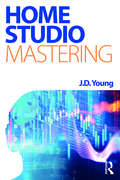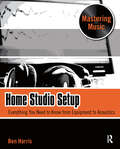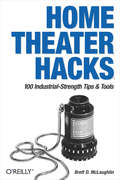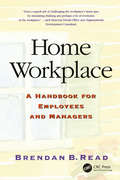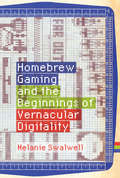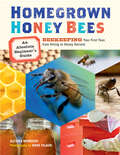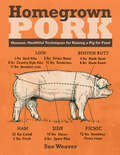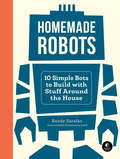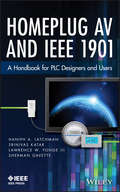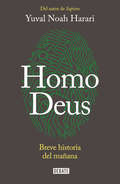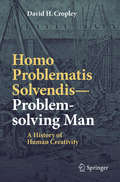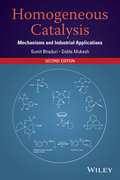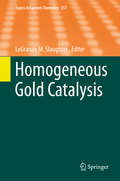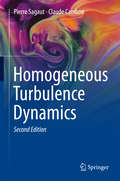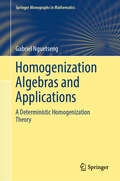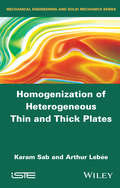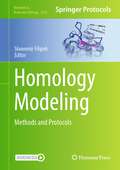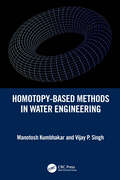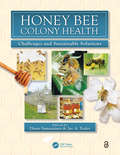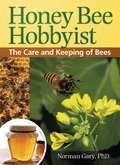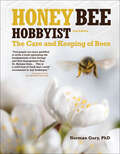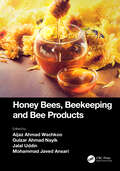- Table View
- List View
Home Studio Mastering
by J.D. YoungHome Studio Mastering is a step-by-step manual that gives you all the tools to professionally master your music yourself. It demystifies the subject in a hands-on way for those working in a home studio and provides comprehensive guidance, from buying equipment and applying acoustical treatment, to using different audio applications and mastering plug-ins. The book is accompanied by five mastering plug-ins (VST/AU/AAX for Mac and PC), to facilitate your personal mastering sessions from start to finish.
Home Studio Setup: Everything You Need To Know From Equipment To Acoustics
by Ben HarrisWhether you have a ton of equipment or just the basic gear this book offers an all you need to know to setting up, running and getting great sound from a project studio. In three parts Harris walks you thought Acoustics, Equipment and Recording Technique. From the basics of acoustic treatment to techniques to solve problems specific to your room, and from offering explanations and information of equipment to how to record and create a great mix. In no time you'll be recording, producing great music in your very own studio.
Home Sweet Zero Energy Home: What It Takes to Develop Great Homes That Won't Cost Anything to Heat, Cool or Light Up, without Going Broke or Crazy
by Barry RehfeldZero energy buildings produce at least as much energy as they consume through a combination of efficiency design and renewable technologies. Home sweet zero energy home shows how developing a better more environmentally friendly home doesn't have to break your back or your bank account.
Home Theater Hacks
by Brett MclaughlinIt might be the long lines at the theater, the $4.00 for a small bag of popcorn, or the cutting-edge technology that's now so readily available to the home market. Whatever the reason, the home theater market today is booming like the soundtrack to Star Wars! Want proof? A Google search for home theater reveals over three million results. Yikes! It's simply undeniable: More and more people prefer watching their favorite movies, television shows, and videos from the comfort of their own sofas and couches. What's also undeniable is the inexperience of most people who choose to install or upgrade their home theaters. Until now, the knowledge, technique, and experiences of those who've encountered similar conditions to yours could only be accessed through laborious web searches, stacks of magazines, and water cooler conversations. Home Theater Hacks from O'Reilly is the perfect remedy for this group. A smart collection of insider tips and tricks, Home Theater Hacks covers home theater installation from start to finish, purchase to experience. Just imagine: no frustrating trial-and-error process and better yet, no expensive appointments with installation experts. Home Theater Hacks prevents both by imparting down-and-dirty technique not found anywhere else. The book begins with a quick glossary of terms so you can speak the lingo when you go shopping, and then dives right into hush-hush, insider tricks. It's all covered where to find the right audio and video components, how to deal with speakers and wiring, understanding cable connectivity, mastering remote controls, how to fully grasp TiVo, and so much more. And to top it off, each of these insider tips is presented in a concise yet delightfully entertaining style. Bringing the Jurassic Park dinosaurs into your living room has never been so easy! A seasoned veteran with numerous O'Reilly titles under his belt, author Brett McLaughlin leaves no stone unturned in helping you customize your home theater experience to your own personal environment.
Home Workplace: A Handbook for Employees and Managers
by Brendan ReadReap the benefits of the home workplace revolution with this practical resource that guides managers and employees through working from home either full or part-time. If you are charged with establishing or executing a home-work policy in your business, t
Homebrew Gaming and the Beginnings of Vernacular Digitality (Game Histories)
by Melanie SwalwellThe overlooked history of an early appropriation of digital technology: the creation of games though coding and hardware hacking by microcomputer users.From the late 1970s through the mid-1980s, low-end microcomputers offered many users their first taste of computing. A major use of these inexpensive 8-bit machines--including the TRS System 80s and the Sinclair, Atari, Microbee, and Commodore ranges--was the development of homebrew games. Users with often self-taught programming skills devised the graphics, sound, and coding for their self-created games. In this book, Melanie Swalwell offers a history of this era of homebrew game development, arguing that it constitutes a significant instance of the early appropriation of digital computing technology. Drawing on interviews and extensive archival research on homebrew creators in 1980s Australia and New Zealand, Swalwell explores the creation of games on microcomputers as a particular mode of everyday engagement with new technology. She discusses the public discourses surrounding microcomputers and programming by home coders; user practices; the development of game creators' ideas, with the game Donut Dilemma as a case study; the widely practiced art of hardware hacking; and the influence of 8-bit aesthetics and gameplay on the contemporary game industry. With Homebrew Gaming and the Beginnings of Vernacular Digitality, Swalwell reclaims a lost chapter in video game history, connecting it to the rich cultural and media theory around everyday life and to critical perspectives on user-generated content.
Homegrown Honey Bees: An Absolute Beginner's Guide to Beekeeping Your First Year, from Hiving to Honey Harvest
by Mars Vilaubi Alethea MorrisonDiscover the joys of harvesting honey from your own backyard. Alethea Morrison outlines what you’ll need to know to make it through the first year, while stunning macrophotography by Mars Vilaubi brings the inner workings of the hive to life. With in-depth discussions of allergies, colony hierarchy, bee behavior, and more, this approachably informative guide bursts with enthusiastic encouragement. Keep your own bees, and enjoy the sweet buzz.
Homegrown Pork: Humane, Healthful Techniques for Raising a Pig for Food
by Sue WeaverRaising a pig for meat is easy to do, even in a small space like a suburban backyard. In just five months, a 30-pound shoat will become a 250-pound hog and provide you with more than 100 pounds of pork, including tenderloin, ham, ribs, bacon, sausage, and more. Homegrown Pork covers everything you need to know to raise your own pig, from selecting a breed to feeding, housing, fencing, health care, and humane processing. Invite all your friends over for a healthy and succulent pork dinner!
Homegrown and Handmade
by Deborah NiemannOur food system is dominated by industrial agriculture and has become economically and environmentally unsustainable. The incidence of diet-related diseases, including obesity, diabetes, hypertension, cancer, and heart disease, has skyrocketed to unprecedented levels. Whether you have forty acres and a mule or a condo with a balcony, you can do more than you think to safeguard your health, your money, and the planet.Homegrown and Handmade shows how making things from scratch and growing at least some of your own food can help you eliminate artificial ingredients from your diet, reduce your carbon footprint, and create a more authentic life. Whether your goal is increasing your self-reliance or becoming a full-fledged homesteader, it's packed with answers and solutions to help you:*Take control of your food supply from seed to plate*Raise small and medium livestock for fun, food, and fiber*Rediscover traditional skills to meet more of your family's needs than you ever thought possibleThis comprehensive guide to food and fiber from scratch proves that attitude and knowledge is more important than acreage. Written from the perspective of a successful self-taught modern homesteader, this well illustrated, practical, and accessible manual will appeal to anyone who dreams of a simpler life.Deborah Niemann is a homesteader, writer, and self-sufficiency expert who presents extensively on topics including soapmaking, bread baking, cheesemaking, composting, and homeschooling. She and her family raise sheep, pigs, cattle, goats, chickens, and turkeys for meat, eggs, and dairy products, while an organic garden and orchard provides fruit and vegetables.
Homemade Robots: 10 Simple Bots to Build with Stuff Around the House
by Randy SarafanHomemade Robots teaches total beginners how to quickly and easily build 10 mobile, autonomous bots with simple tools and common household materials. A Perfect DIY STEAM adventure for the electronically curious. Homemade Robots is a beginner&’s guide to building a wide range of mobile, autonomous bots using common household materials. Its 10 creative and easy-to-follow projects are designed to maximize fun with minimal effort—no electronics experience necessary! From the teetering Wobbler to the rolling Barreller, each bot is self-driving and has a unique personality. There&’s the aptly named Inchworm Bot made of aluminum rulers; Buffer, a street sweeper-like bot that polishes the floor as it walks; and Sail Bot, which changes direction based on the wind. Randy Sarafan&’s hacker approach to sculptural robotics will appeal to builders of all ages. You&’ll learn basic electronics, get comfortable with tools and mechanical systems, and gain the confidence to explore further on your own. A wide world of robots is yours to discover, and Homemade Robots is the perfect starting point.
Homeplug AV and IEEE 1901
by Larry Yonge Sherman Gavette Srinivas Katar Haniph A. LatchmanThe only authorized book explaining the HomePlug networking standardsHomePlug is a growing technology for creating high-speed Power Line Communication (PLC) networks by transmitting data over in-home or in-office power lines. Users only need to plug adapters into wall outlets to create an instant network of computers, printers, routers, home entertainment devices, and appliance control systems.HomePlug AV and IEEE 1901: A Handbook for PLC Designers and Users provides for the first time an opportunity for non-members of the HomePlug Alliance to gain in-depth insight into the design and operation of the HomePlug standards. Offering a clear and simple description of the standards, this groundbreaking resource presents HomePlug AV and the associated IEEE 1901 standards in terms more readily understood by a much wider audience, including nontechnical managers, engineers, students, and HomePlug designers.The book details the many benefits of HomePlug AV, including:An affordable, secure alternative or complement to WiFi--especially in buildings where WiFi reception is poor or running new network wires is impracticalHigher potential data transmission rates up to 200 MbpsSupport for multimedia applications such as HDTV and VoIPThe book also provides an overview of the HomePlug Green PHY standard that is targeted for use in smart energy applications, and the HomePlug AV 2.0 standard that operates at up to 1.5 Gbps.An essential tool for designers of HomePlug devices, network administrators, and individual users of HomePlug networks who need to understand the features and capabilities of HomePlug, HomePlug AV and IEEE 1901: A Handbook for PLC Designers and Users will also prove useful for researchers in academia and the power line communications industry.
Homo Deus: Breve historia del mañana
by Yuval Noah HarariTras el éxito de Sapiens. De animales a dioses, Yuval Noah Harari vuelve su mirada al futuro para ver hacia dónde nos dirigimos. La guerra es algo obsoleto. Es más probable quitarse la vida que morir en un conflicto bélico. La hambruna está desapareciendo. Es más habitual sufrir obesidad que pasar hambre. La muerte es solo un problema técnico. Adiós igualdad. Hola inmortalidad. ¿Qué nos depara el futuro? Yuval Noah Harari, autor bestseller de Sapiens. De animales a dioses, augura un mundo no tan lejano en el cual nos veremos enfrentados a una nueva serie de retos. Homo Deus explora los proyectos, los sueños y las pesadillas que irán moldeando el siglo XXI -desde superar la muerte hasta la creación de la inteligencia artificial. - Cuando tu Smartphone te conozca mejor de lo que te conoces a ti mismo, ¿seguirás escogiendo tu trabajo, a tu pareja y a tu presidente? - Cuando la inteligencia artificial nos desmarque del mercado laboral, ¿encontrarán los millones de desempleados algún tipo de significado en las drogas o los juegos virtuales? - Cuando los cuerpos y cerebros sean productos de diseño, ¿cederá la selección natural el paso al diseño inteligente? Esto es el futuro de la evolución. Esto es Homo Deus.
Homo Problematis Solvendis–Problem-solving Man: A History of Human Creativity
by David H. CropleyThis book presents the history of modern human creativity/innovation through examples of solutions to basic human needs that have been developed over time. The title – Homo problematis solvendis – is a play on the scientific classifications of humans (e.g. Homo habilus, Homo erectus, Homo sapiens), and is intended to suggest that a defining characteristic of modern humans is our fundamental ability to solve problems (i.e. problem- solving human = Homo problematis solvendis). The book not only offers new perspectives on the history of technology, but also helps readers connect the popular interest in creativity and innovation (in schools, in businesses) with their psychological underpinnings. It discusses why creativity and innovation are vital to societies, and how these key abilities have made it possible for societies to develop into what they are today.
Homogeneous Catalysis
by Doble Mukesh Sumit BhaduriOver the last decade, the area of homogeneous catalysis with transition metal has grown in great scientific interest and technological promise, with research in this area earning three Nobel Prizes and filing thousands of patents relating to metallocene and non-metallocene single site catalysts, asymmetric catalysis, carbon-carbon bond forming metathesis and cross coupling reactions.This text explains these new developments in a unified, cogent, and comprehensible manner while also detailing earlier discoveries and the fundamentals of homogeneous catalysis. Serving as a self-study guide for students and all chemists seeking to gain entry into this field, it can also be used by experienced researchers from both academia and industry for referring to leading state of the art review articles and patents, and also as a quick self-study manual in an area that is outside their immediate expertise. The book features:* Topics including renewable feed stocks (biofuel, glycerol), carbon dioxide based processes (polycarbonates), fluorous solvents, ionic liquid, hydroformylation, polymerization, oxidation, asymmetric catalysis, and more * Basic principles of organometallic chemistry, homogeneous catalysis, and relevant technological issues* Problems and answers, industrial applications (case studies), and examples from proven industrial processes with clear discussions on environmental and techno-commercial issues* Extensive references to cutting edge research with application potential and leading patents* Tables and illustrations to help explain difficult concepts
Homogeneous Catalysis with Metal Complexes
by Gheorghe DucaThe book about homogeneous catalysis with metal complexes deals with the description of the reductive-oxidative, metal complexes in a liquid phase (in polar solvents, mainly in water, and less in nonpolar solvents). The exceptional importance of the redox processes in chemical systems, in the reactions occuring in living organisms, the environmental processes, atmosphere, water, soil, and in industrial technologies (especially in food-processing industries) is discussed. The detailed practical aspects of the established regularities are explained for solving the specific practical tasks in various fields of industrial chemistry, biochemistry, medicine, analytical chemistry and ecological chemistry. The main scope of the book is the survey and systematization of the latest advances in homogeneous catalysis with metal complexes. It gives an overview of the research results and practical experience accumulated by the author during the last decade.
Homogeneous Gold Catalysis
by Legrande M. SlaughterThe series Topics in Current Chemistry presents critical reviews of the present and future trends in modern chemical research. The scope of coverage is all areas of chemical science including the interfaces with related disciplines such as biology, medicine and materials science. The goal of each thematic volume is to give the non-specialist reader, whether in academia or industry, a comprehensive insight into an area where new research is emerging which is of interest to a larger scientific audience. Each review within the volume critically surveys one aspect of that topic and places it within the context of the volume as a whole. The most significant developments of the last 5 to 10 years are presented using selected examples to illustrate the principles discussed. The coverage is not intended to be an exhaustive summary of the field or include large quantities of data, but should rather be conceptual, concentrating on the methodological thinking that will allow the non-specialist reader to understand the information presented. Contributions also offer an outlook on potential future developments in the field. Review articles for the individual volumes are invited by the volume editors. Readership: research chemists at universities or in industry, graduate students.
Homogeneous Turbulence Dynamics
by Pierre Sagaut Claude CambonThis book provides state-of-the-art results and theories in homogeneous turbulence, including anisotropy and compressibility effects with extension to quantum turbulence, magneto-hydodynamic turbulence and turbulence in non-newtonian fluids. Each chapter is devoted to a given type of interaction (strain, rotation, shear, etc.), and presents and compares experimental data, numerical results, analysis of the Reynolds stress budget equations and advanced multipoint spectral theories. The role of both linear and non-linear mechanisms is emphasized. The link between the statistical properties and the dynamics of coherent structures is also addressed. Despite its restriction to homogeneous turbulence, the book is of interest to all people working in turbulence, since the basic physical mechanisms which are present in all turbulent flows are explained. The reader will find a unified presentation of the results and a clear presentation of existing controversies. Special attention is given to bridge the results obtained in different research communities. Mathematical tools and advanced physical models are detailed in dedicated chapters.
Homogenization Algebras and Applications: A Deterministic Homogenization Theory (Springer Monographs in Mathematics)
by Gabriel NguetsengThe book presents a deterministic homogenization theory intended for the mathematical analysis of non-stochastic multiscale problems, both within and beyond the periodic setting. The main tools are the so-called homogenization algebras, the classical Gelfand representation theory, and a class of actions by the multiplicative group of positive real numbers on numerical spaces. The basic approach is the Sigma-convergence method, which generalizes the well-known two-scale convergence procedure. Numerous problems are worked out to illustrate the theory and highlight its broad applicability. The book is primarily intended for researchers (including PhD students) and lecturers interested in periodic as well as non-periodic homogenization theory.
Homogenization of Heterogeneous Thin and Thick Plates
by Arthur Lebée Karam SabThis book gives new insight on plate models in the linear elasticity framework tacking into account heterogeneities and thickness effects. It is targeted to graduate students how want to discover plate models but deals also with latest developments on higher order models. Plates models are both an ancient matter and a still active field of research. First attempts date back to the beginning of the 19th century with Sophie Germain. Very efficient models have been suggested for homogeneous and isotropic plates by Love (1888) for thin plates and Reissner (1945) for thick plates. However, the extension of such models to more general situations --such as laminated plates with highly anisotropic layers-- and periodic plates --such as honeycomb sandwich panels-- raised a number of difficulties. An extremely wide literature is accessible on these questions, from very simplistic approaches, which are very limited, to extremely elaborated mathematical theories, which might refrain the beginner. Starting from continuum mechanics concepts, this book introduces plate models of progressive complexity and tackles rigorously the influence of the thickness of the plate and of the heterogeneity. It provides also latest research results. The major part of the book deals with a new theory which is the extension to general situations of the well established Reissner-Mindlin theory. These results are completely new and give a new insight to some aspects of plate theories which were controversial till recently.
Homology Modeling: Methods and Protocols (Methods in Molecular Biology #2627)
by Sławomir FilipekThis detailed volume provides state-of-the-art methodologies and reviews of important topics in the field of homology modeling. From homology modeling in the twilight zone and improving accuracy through sequence space analysis to approaches to construct multi-protein complex models, the book explores a wide variety of uses and applications of this valuable technique. Written for the highly successful Methods in Molecular Biology series, the chapters include introductions to their respective topics, lists of the necessary programs, webservers, and databases, step-by-step and readily reproducible protocols, as well as tips on troubleshooting and avoiding known pitfalls. Authoritative and practical, Homology Modeling: Methods and Protocols serves as an ideal guide to recent homology modeling procedures, assumptions made, and model quality assessment that will illuminate the black box of homology modeling for novice readers and broaden the knowledge of this methodology for professionals.
Homotopy-Based Methods in Water Engineering
by Vijay P. Singh Manotosh KumbhakarMost complex physical phenomena can be described by nonlinear equations, specifically, differential equations. In water engineering, nonlinear differential equations play a vital role in modeling physical processes. Analytical solutions to strong nonlinear problems are not easily tractable, and existing techniques are problem-specific and applicable for specific types of equations. Exploring the concept of homotopy from topology, different kinds of homotopy-based methods have been proposed for analytically solving nonlinear differential equations, given by approximate series solutions. Homotopy-Based Methods in Water Engineering attempts to present the wide applicability of these methods to water engineering problems. It solves all kinds of nonlinear equations, namely algebraic/transcendental equations, ordinary differential equations (ODEs), systems of ODEs, partial differential equations (PDEs), systems of PDEs, and integro-differential equations using the homotopy-based methods. The content of the book deals with some selected problems of hydraulics of open-channel flow (with or without sediment transport), groundwater hydrology, surface-water hydrology, general Burger’s equation, and water quality. Features: Provides analytical treatments to some key problems in water engineering Describes the applicability of homotopy-based methods for solving nonlinear equations, particularly differential equations Compares different approaches in dealing with issues of nonlinearity
Honey Bee Colony Health: Challenges and Sustainable Solutions
by K. M. M. PrabhuThis book summarizes the current progress of bee researchers investigating the status of honey bees and possible reasons for their decline, providing a basis for establishing management methods that maintain colony health. Integrating discussion of Colony Collapse Disorder, the chapters provide information on the new microsporidian Nosema ceranae pathogens, the current status of the parasitic bee mites, updates on bee viruses, and the effects these problems are having on our important bee pollinators. The text also presents methods for diagnosing diseases and includes color illustrations and tables.
Honey Bee Hobbyist
by Norman GaryBee keeping isn't just for the professional farmer-bees can be kept in any situation from the simple backyard patio and garden to large expanses of farm land. This comprehensive and attractive beekeeping guide, from Hobby Farm Press, the same people who bring you Hobby Farms and Hobby Farm Home magazine, Beekeeping takes readers from finding their bees, housing them, collecting honey and using their produce for pleasure and possible profit. This colorful book, including entertaining chapters on the history of bees and beekeeping, serves as an extensive introduction to help novice beekeepers fully understand this exciting hobby!
Honey Bee Hobbyist: The Care and Keeping of Bees
by Norman GaryA beginning apiarist’s comprehensive guide to keeping bees at home, from basic bee biology to the necessary tools, and more.Discover the secrets of successful hobby beekeeping with advice from a world-renowned honey bee expert. Dr. Norman Gary shares his extensive beekeeping expertise in this entertaining and authoritative guide. Honey Bee Hobbyist, 2nd Edition will help you decide whether hobby beekeeping is right for you and will introduce you to all of the equipment, tools, and protective clothing you’ll need to get started.Dr. Gary teaches you to understand bee behavior so you can relax and enjoy working with these amazing creatures. He takes you from assembling your new hive and stocking it with bees to managing a growing colony and harvesting your honey rewards. With fascinating color photographs, myth-busting insights, and never-before-published tips, this comprehensive handbook is your first step toward an enjoyable and rewarding lifelong hobby.Inside you’ll find:Detailed, practical instructions for hobby beekeepingBasics of honey bee anatomy, behavior, and reproductionHow to use a bee smoker and safely open a hiveHow to monitor hive conditions, prevent swarming, and deal with bee diseasesEffective sting-prevention strategiesFun ways to use your beekeeping hobby for entertainment and educationUpdated information on beekeeping in urban environments“Few people are more qualified to write a book explaining the fundamentals of bee biology and hive management than Dr. Norman Gary… This is a solid how-to book that I could recommend to any beekeeper.”—Dr. James E. Tew, The Ohio State University“As practical as it is engaging, Honey Bee Hobbyist by University of California, Davis, entomologist Norman Gary can help you decide if backyard beekeeping is for you and how to go about it. Learn all about these important pollinators, including the intricacies of bee reproduction and society, how to use surplus honey, and why most people shouldn’t be overly afraid of a bee’s sting.”—California Bountiful Magazine
Honey Bees, Beekeeping and Bee Products
by Aijaz Ahmad Wachkoo, Gulzar Ahmad Nayik, Jalal Uddin and Mohammad Javed AnsariHoney bees are social insects; they live together in large, well-organized family groups comprising three castes: queen (fertile female), workers (sterile females) and drones (males). During honey flow season, there is a considerable increase in the foraging activity of the workers and in the rate of egg laying by the queen. Sex determination in honey bees involves a multi-allelic locus, such that homozygotes develop as males and heterozygotes as females, whereas diet quality influences the caste determination in honey bees. Like all living organisms, honey bees can be infested with diseases and pests. Some of these are more deleterious to bee colonies than others, but it is important for the beekeeper to be able to recognize conditions that might be disease or pest-related and respond accordingly so as to improve the quality of honey and honey bee by-products.The best-known primary products of beekeeping are honey and wax, but pollen, propolis, royal jelly, venom, queens, bees and their larvae are also marketable primary bee products. The purpose of this book is to make available information on bee biology and beekeeping as well as to provide comprehensive information on manufacturing, processing and marketing of value-added bee products.This book has been designed as a useful tool for the many diverse professionals who characterize and market honey bee products, including beekeepers, non-beekeepers, small entrepreneurs, extension officers and those involved in small business development. This edited book will be the first of its kind to contain comprehensive information on both bees and bee products.Key Features: Contains comprehensive information on beekeeping. Discusses the recent advances in beekeeping. Sheds light on bee colony integration and organization. Contains brief information on honey bee products.
